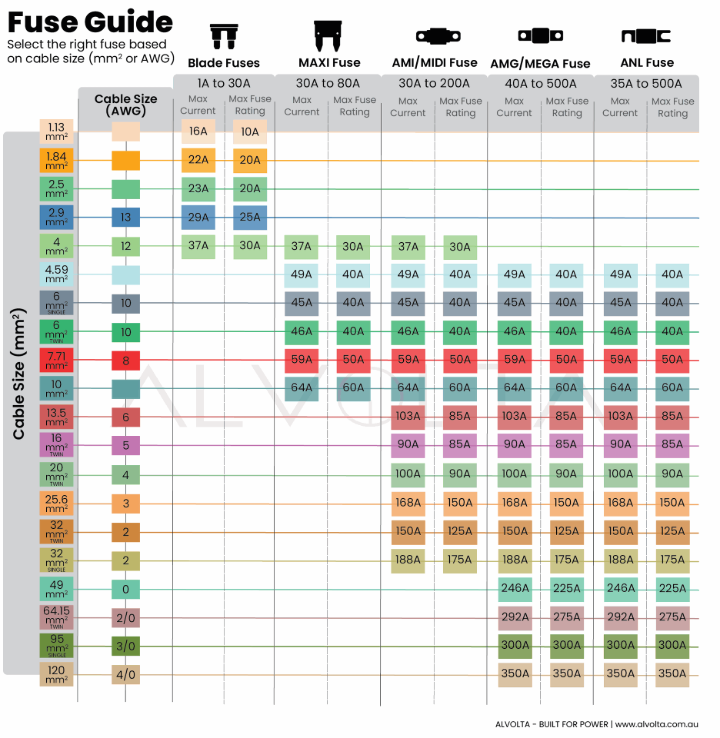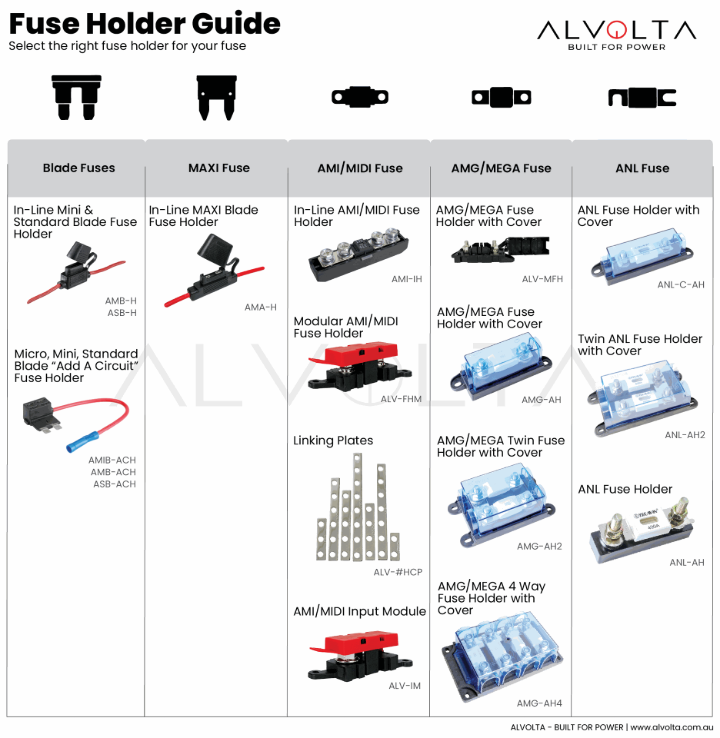When designing a DC system - whether it’s for an inverter, MPPT, fridge, or DC-DC charger - selecting the correct fuse size is critical for safety and system performance. But contrary to popular belief, you don’t size your fuse directly to your load - you size it to your cable, which is selected based on your load.
This blog will guide you through the steps to size your fuse and ensure your system is protected properly.
1. Understand the fuse-cable-load relationship
In any 12V, 24V, or 48V system, the fuse sits between your power source and your load. A typical setup looks like this:
Battery Fuse Cable Inverter (Load)
The purpose of the fuse is to protect the cable, not the device. If your inverter, charger, or appliance fails, you want the fuse to blow before your cable overheats and risks fire.
Read more: 5 tips to tidy your DC & wiring setup
2. Confirm your inverter's power rating
Start with your load - in this case, the inverter.
- Check if the rating is in Watts (W) or Volt-Amps (VA)
- Make sure the inverter can meet the total power needs of your connected appliances.
Example
If you have a 1000W inverter, ensure your cable and fuse can handle the associated current.
3. Know your system voltage
Determine your system voltage: 12V, 24V, or 48V - usually the voltage of the battery bank. This impacts your current draw and what fuse types are compatible.
Important
Don't use a fuse rated for less than your system's voltage. For instance, a 24V fuse is not suitable for a 48V system.
4. Calculate your maximum current draw
To figure out the maximum current your load will pull, use this formula:
Current (Amps) = Power (Watts) ÷ Voltage (Volts)
Then multiply by 1.5 for safety and future-proofing.
Example
1000W ÷ 12V = 83.3A
83.3A x 1.5 = 125A (use this value to size your cable)
5. Choose the right cable size
Use a cable size calculator with your max current and cable length to determine the correct gauge. Always size up if unsure - an oversized cable is safer and reduces voltage drop.
Read more: What size cable do I need? LV cable sizing guide
6. Determine the correct fuse size
Now that you know your cable size, choose a fuse that meets the following criteria:
- Greater than your system’s max current draw
- Less than your cable’s amp rating
- As close as possible to your cable’s rating (without exceeding it)
This ensures the fuse blows before the cable becomes a hazard, but not so early that it interrupts normal usage.

7. Select the right fuse type
Choose a fuse type based on your application:
- Mega fuses: common for high-current applications (battery to inverter)
- ANL fuses: great for large lithium systems (high current + low voltage drop)
- Midi fuses: suitable for MPPTs and DC-DC chargers
- Standard blade fuses: ideal for low-current loads like fridges or lights
Please note that a manual reset circuit breaker could also be used in place of a fuse. It’s a question of preference when selecting either a fuse or a circuit breaker for your load.
Read more: DC circuit protection guide

Wrapping Up
Fuse selection isn’t just about protecting your inverter - it’s about safeguarding your cables, your vehicle, and your home. By calculating your current draw, sizing your cable accordingly, and selecting a matching fuse, you’ll have a safe, efficient, and reliable electrical system.
Need help picking the right fuse or cable? Our team can help you choose components that meet your system’s demands.
Shop Alvolta for a complete 12/24V DC solution for your off-grid adventures or remote systems.
Contact our DC component experts for assistance in setting up a 12/24V system. We are an Australian-founded and operated company, providing expert advice for over 23 years.
How To Choose The Right Fuse Size For Your Load